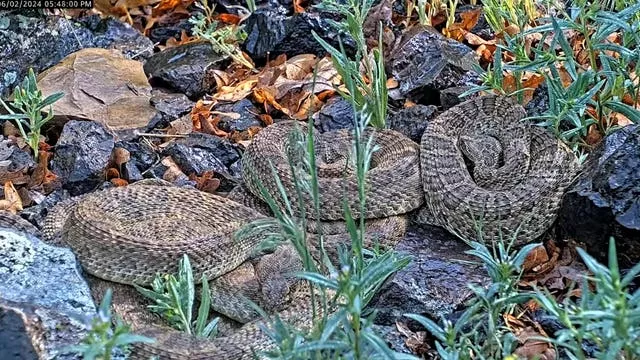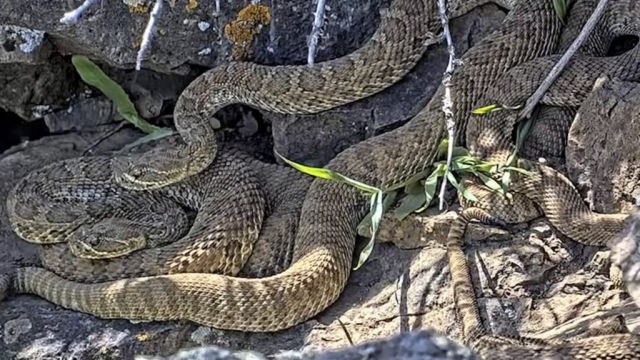A “mega den” of up to 2,000 rattlesnakes at a remote location in northern Colorado is now available for live, round-the-clock viewing online.
California Polytechnic State University scientists recently put up a webcam at what they say is one of the biggest rattlesnake dens they have ever seen.
While hundreds of rattlesnakes may not top binge-watching lists for many people, it is a viewing bonanza for scientists and other snake enthusiasts whose observations are helping to broaden understanding of these unusual – and undeservedly maligned – reptiles.
The goal is twofold: to reveal how rattlesnakes behave when people are not nearby, and to bring in the public to spot details about the snakes and surrounding environment that might otherwise be overlooked.
The remote site on private land in northern Colorado is on a hillside full of rock crevices where the snakes can keep warm and hide from predators.

Cal Poly biology professor Emily Taylor, who is leading the Project RattleCam study, said: “This is a big, big den for rattlesnakes. This is one of the biggest ones we know of.”
Researchers set up the webcam in May, working off their knowledge from a previous webcam they set up at a rattlesnake den in California.
The exact location in Colorado is kept secret to discourage snake lovers – or haters – from interfering with the snakes, Prof Taylor said.
The high-elevation Colorado rattlesnakes take refuge in the den for winter and emerge in the spring for a short season of activity compared to rattlesnakes in the US south-west.
At this time of year, only pregnant female snakes are at the den while males and not-pregnant females move into the lower country nearby.
In August, the babies will be born. They are called pups and, unlike nearly all other reptiles, they do not hatch from eggs but are born alive.
Also unlike other snakes, rattlesnake mothers care for their young, protecting them against predators and shielding them with their bodies. Sometimes rattlesnakes even care for the young of others.
“Rattlesnakes are actually really good mothers. People don’t know that,” Prof Taylor said.

A webcam helps scientists observe snake behaviour without interfering. Meanwhile, people watching online tip off scientists to events they miss, or clue them in with their own knowledge about the local environment.
“It truly is a group effort, a community science effort, that we couldn’t do on our own as scientists,” Prof Taylor said.
Now and then, there is drama. Red-tailed hawks circle above, awaiting a chance to swoop in for a meal. Once, a magpie caught a baby rattlesnake.
When it rains, the rattlesnakes coil up and catch water to drink from the cups formed by their bodies.
Prof Taylor expects a surge in activity after the pups are born – then even more in September as snakes return from surrounding areas in preparation for winter.
Rattlesnakes have an undeserved reputation of being creepy and threatening. But the webcam shows they are social animals that do not go out of their way to be aggressive, Prof Taylor pointed out.
She said: “I try to speak up for the underdog and to show people that rattlesnakes have this other side that’s really worthy of our admiration.”







